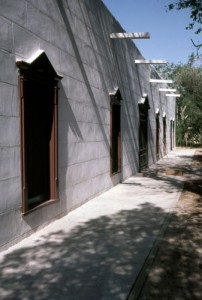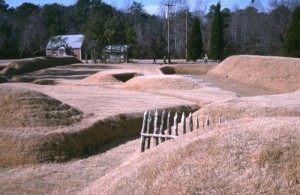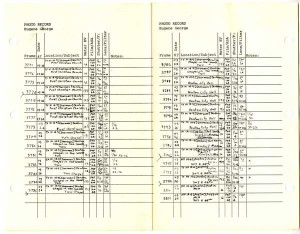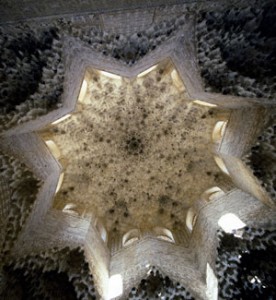Come enjoy a special centennial exhibit “Our Landmark Library: Battle Hall at 100,” featured in the Architecture & Planning Library’s reading room. The exhibit revisits the history of the university’s first dedicated library space on campus through imagery drawn from sources including the Dolph Briscoe Center for American History, the Alexander Architecture Archive, the New-York Historical Society and the Library of Congress. An accompanying online exhibit offers additional images and information conveying the story of the building from conception to completion. The Architecture and Planning Library will be open from 12:00 pm to 6:00 pm.
Category Archives: News Items
Blake Alexander Memorial Service Announced
The University of Texas Libraries and the School of Architecture will hold a memorial gathering to celebrate the life of Blake Alexander on Saturday, April 28, 2012 from 3-5pm in the Battle Hall Reading Room of the Architecture & Planning Library Forthcoming details will be shared in eNews and on the Alexander Architectural Archive web site.
The Alexander family asks that memorial contributions be made to the Alexander Architectural Archive or the Architecture & Planning Library. Please contact Beth Dodd at apl-aaa@lib.utexas.edu or donate online.
For further inquiry please contact Nancy Sparrow at 512-495-4621.
Library reading room disruptions 10/14 to 10/21
As part of the Music in Architecture/Architecture in Music symposium, the Architecture & Planning Library will be hosting Ellen Fullman‘s performance Tracings -Work for the Long String Instrument on Thursday October 20th at 8:30 pm.
In preparation for this performance, we will be moving furniture in the reading room on the afternoon of Friday October 14 to accommodate the Long String Instrument. Access to materials in the reading room (current journals and the reference collection) will still be possible at this stage but will be very limited all day Thursday Oct 20 and until the afternoon of Friday Oct 21.
There will be further disruptions in the reading room (higher than usual noise level) during the assemblage of the Long String Instrument this weekend and rehearsals next week. However, general and reserve collections and circulation services will not be affected except for the night of the performance (Thursday Oct 20th) when the library will be closing at 6 pm.
More details regarding this event will follow.
New Collections, Maps, and Turtles!
Howdy all, and welcome back for another Mayaland Adventure! I hope everybody enjoyed the Independence Day weekend. The Architecture and Planning Library and Alexander Architectural Archive were closed over the weekend to celebrate, so it’s good to be back.
Recently, along with the volunteering on George F. and Gerrie D. Andrews Maya Architecture Collection, I worked with Donna Coates on accessioning a new collection. The process requires understanding the difference between relevant information and data for the archive, and that which is not pertinent to keep.
Some of the material is not kept because we can get copies online or within other resources, which includes items such as government documents or photocopies of publications. These items, though at times are rather interesting, cannot be kept due to limited space. With limited space comes a higher diligence for selecting essentials, and leaving items that are easily accessible elsewhere.
During the process of obtain new collections, we must also work to not get rid of aspects which another archive or department might use. Just because something does not apply to our archive does not necessarily mean someone else cannot use it. This is why we work with other facilities on campus or in town that might have use for the extra material. It is this cooperation that creates a friendly environment in the archival community.
Back in the George F. and Gerrie D. Andrews Maya Collection, we got together Friday to discuss the progress thus far, and how each member of the team thought the processing should continue. Ian brought up a good point that for the final sorting the collection should be placed into country categories, followed by alphabetical site sorting. This would allow researchers to acquire access to a specific region, instead of sifting through the entire collection. This is important for the archive as well because it prevents the material from being overly handled.
We also discussed how we would house the Andrew’s photos and writings. The decision we must make is whether to kept everything together, or boxed separately. This item is still up in the air at the moment. It seems, at least from my view that it would be useful to have the groups separate, because individuals would be likely to be looking specifically for photos or documentation, not necessarily both. It also feels more organized.
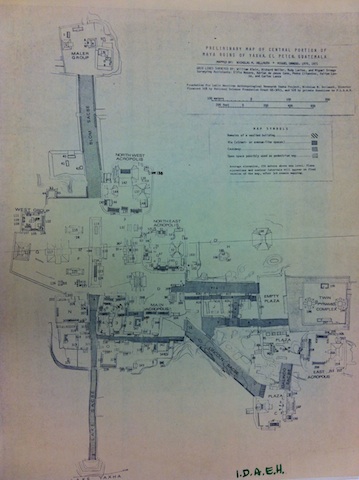
The problem arises, however, with items that are contained in the documentation that fit better within the photos portion. Here would be required to make sure to have detailed notation of each item to create a complete inventory. We also must find a place for all the drawings and sketches present within the collection. This includes maps, stelae and masks, and graffiti. These are just a couple of the questions the team faces as we continue work on the collection.
Before heading out, check out this cool photo I found while sorting. It is the ‘casa de las tortugas’ or House of the Turtles! You can see a rough scale of the building based on the individual standing in front. Enjoy las tortugas, and until next time this is Austin from Mayaland, signing off.

Eugene George Papers document historic preservation in Texas
What do the Magoffin Adobe in El Paso, the Moody Mansion in Galveston, and a Revolutionary War battlefield in Yorktown, Virginia, all have in common?
They’re all historic preservation projects undertaken by noted architect and former UT faculty member Eugene George — and they’re all documented in the Walter Eugene George Collection at the Alexander Architectural Archive.
With 12,000 slides, thousands of negatives and photographic prints, hundreds of architectural drawings, and approximately nine linear feet of professional records, the Eugene George Papers are a window into the field of historic preservation in Texas and beyond.
George’s approach to historic preservation is intensely scholarly, and his voluminous reference files provide a resource for students and scholars interested in all areas concerning historic preservation. The George Collection also contain a wealth of photographic materials, which add a visual dimension to the record of his activities as a practicing architect, scholar, educator and photographer. Beginning in 1979, George extensively documented each of his photographs, assigning each a frame number and logging the subject, date, and technical information. In addition to providing evidence of historic preservation projects in process, the photographic materials are a rich visual resource for architecture, landscapes, and cultures around the world.
Look for an updated finding aid online soon, and don’t miss a new digital exhibition in December for more details on George and his career.
Family Weekend 2010
Welcome Families!
Friday, October 15-Sunday, October 17
The Architecture & Planning Library will be open regular hours: Saturday 12-6 & Sunday 1-7
There are many interesting highlights that you may enjoy including:
- reading room exhibit
Maya Architecture: Selections from the George F. and Geraldine Andrews Collection. - library entrance foyer
Battle Hall exhibit case - stair well installation
Journals On(_)line(s) - archive entrance foyer
UT Centennial models of campus, exhibit about the archive, exhibit on preservation efforts in the archive
Enjoy!
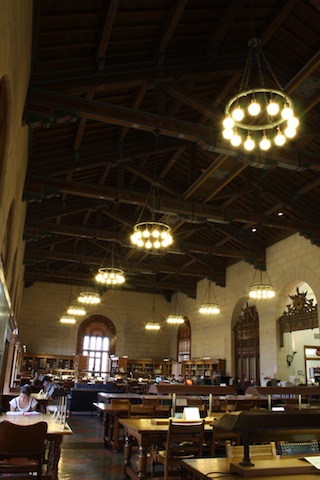
Special Collections – Summer 2010
During the 2010 summer session, the Architecture and Planning Library has initiated a number of projects that will provide greater access to the content located in the library’s special collections. Supported by the John Green Taylor Endowment and through the generous service of volunteers, these projects will promote special collections use by enhancing collection records and marketing its contents.
Graduate students from a number of disciplines are currently working to index individual collections, generate more comprehensive provenance notes, and develop web content that facilitates collection navigation. These projects are part of an ongoing effort to expose the rich and diverse materials held in the library’s special collections.
With over 20,000 volumes, special collections comprise almost 1/5th of the library’s holdings and function as an invaluable resource for scholars in the disciplines of architecture, art and architectural history, landscape architecture, community and regional planning, building technology and construction science.
Transparent People: reBILD installation at the library
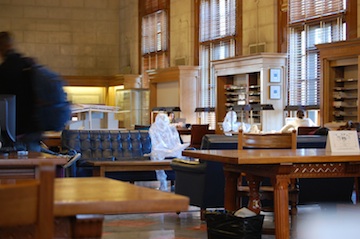 reBILD installation at the Architecture & Planning Library Reading Room. To see full size image, click here.
reBILD installation at the Architecture & Planning Library Reading Room. To see full size image, click here.
On February 25, 2010, reBILD created an installation in UT’s Architecture and Planning Library featuring
8 full-scale “statues” of people made of transparent tape and plastic-wrap arranged to appear as active patrons of the library. This specific location was chosen because of the light quality, scale and design of the main room, as well as the unique condition of libraries as spaces that discourage talking, altering what might otherwise be predictable reactions to this spatial intervention. A particularly surprising aspect of the project was the degree to which different kinds and amounts of light (natural, artificial, direct, indirect, etc.) dramatically changed the effect of the sculptures and, thus, changed their spatial presence.
reBILD plans to use observations made from this project as a starting point to inform their next project, which should be in late March.
reBILD is a student group at the University of Texas at Austin School of Architecture building on the initiatives of Linus Day, a 19th century experimental artist/architect. Our aim is to challenge preconceived notions of spatial experience and document the results to inform a wider sense of design. reBILD hopes to accomplish this goal by developing fun and decidedly unscientific experiments that alter spatial conditions and engage the community. reBILD grew out of a project that the founding students undertook as part of a Theory of Architecture class with Larry Speck, the organization’s advisor.
To see other images of this installation, visit the slide show on the Architecture & Planning Library flickr page.
Historic Preservation Program: A Retrospective of Student Work, 2008-2009
 Historic Preservation Program: A Retrospective of Student Work, 2008-2009 exhibtion on view at the Architecture & Planning Library Reading Room. To see full size invitation, click here.
Historic Preservation Program: A Retrospective of Student Work, 2008-2009 exhibtion on view at the Architecture & Planning Library Reading Room. To see full size invitation, click here.
“Historic Preservation Program: A Retrospective of Student Work, 2008-2009” will be open in the Architecture & Planning Library Reading Room in Battle Hall March 6 through May 24, 2010.
Presented by the Graduate Program in Historic Preservation and curated by a committee of students, the exhibition showcases the products of various preservation classes from the past two years, including Preservation Studio, Graphic Documentation, and Materials Conservation. The works on display from the multi-disciplinary classes include annotated drawings for building condition assessments, HABS-level documentation measured drawings, design proposals, photographs, and models.
Austin sites, including historic campus buildings, are the focus of all of the projects. This exhibit offers a preservation perspective for conservation, documentation, as well as exploration of new design ideas for several of the city and the university’s historic resources.
Sponsored by: The University of Texas at Austin School of Architecture, the University of Texas Libraries, the Texas Union Student Events CoSponsorship Committee, the Graduate Student Assembly, the Senate of College Councils, Kemp Properties and the Paul C. Ragsdale Excellence Fund for Historic Preservation.
Dodd speaks at Texas Preservation Summit, February 5, 2010
Beth Dodd, Head Librarian at the Architecture & Planning Library, participated on a panel discussion at the “Modernism + Recent past” roundtable. The panel, made up of 6 professionals involved in historic preservation, spoke about their experiences and issues related to modernism and the recent past. In an organized discussion, key themes of awareness, advocacy and action were addressed to identify specific challenges inherent in preserving the recent past with the end goal of suggesting proactive solutions statewide.
Discussion included an understanding that access to knowledge plays a significant role in historic preservation. That open access and preservation of historic records must go hand in hand with the preservation of the building. Modern buildings and their records share similar challenges including identification, documentation and preservation. It was an opportunity to raise awareness about the incredible unique resources found in the University of Texas Libraries’ Alexander Architectural Archive- a public keeper and steward of knowledge. Solutions included proactively identifying historic records, raising awareness of public repositories, and encouragement to increase web presence and the use of Web 2.0 for sharing knowledge and images. A stronger web presence helps in research and proves international interest in what might more commonly be considered a local issue.
The Preservation Summit, sponsored by Preservation Texas, was organized as an opportunity to identify issues related to the preservation of the historic built environment, develop strategic approaches and solutions to issues and to cultivate partnerships across the state.


